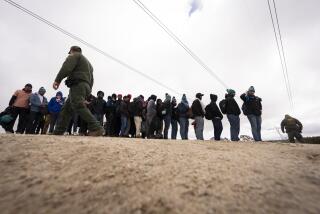Miami Reacts With Charity and Anxiety to Latest Refugee Influx From Nicaragua
MIAMI — Governments rise and governments fall, and this is where the losing side so often starts over. Se habla espanol in Miami, and most everyone has a cousin here with a spare bed. The rich quickly buy a condo on the water, and the poor talk their dreams to sleep under the shade of a palm.
Ask the Cubans, who have arrived in trickles, spurts and one great gush of 125,000--the ragtag Mariel armada of 1980. This city thought it finally had absorbed them all, when this year began instead with a new flood of refugees.
Over the weekend, busloads of Nicaraguans poured into a Miami that was more prepared for a jewel-daubed, jet-set Super Bowl crowd than a scruffy throng of penniless and confused aliens.
Predictions are that this is just the beginning. As many as 100,000 are expected to arrive during 1989, an influx that is making state and local officials gasp, for who, dear Uncle Sam, is going to pay the bills?
“This is a national matter prompted by our nation’s foreign policies, and this burden must be shared with the federal government and the citizens of the other 49 states,” Gov. Bob Martinez wrote last week in a letter to U.S. Atty. Gen. Dick Thornburgh.
Florida officials see events as a kind of Rube Goldberg contraption, at the end of which Miami gets a whack in the jaw: The Reagan Administration’s policy against the Sandinistas has miscarried. That has contributed to an exodus from Nicaragua. Immigration authorities cannot control U.S. borders. Thousands leave for haven in America. To most of them, America means Miami.
“The federal government largely turned its back on the taxpayers of Florida during the Mariel boat lift . . . and the people of this state simply will not abide being abandoned once again,” Gov. Martinez said.
In 1980, President Jimmy Carter encouraged Cubans to board a “freedom flotilla” across the Florida Straits. State and local taxpayers were burdened with huge costs to care for the refugees, and federal reimbursement fell an estimated $100 million short.
Now, there is the sense that Miami is in for it yet again. Civic leaders have gone off to Washington to protest. Editorialists are breathless.
The stream has “the potential of swelling into a tidal wave that would engulf Greater Miami, causing social and economic destruction more severe than any American city anywhere has ever experienced,” said the Miami Herald last week.
The Nicaraguans mostly arrive aboard Greyhound buses, the seats all full but the cargo holds empty. The refugees often have nothing more with them than a vague idea of a single place--mystical, abundant, beckoning: Miami.
In a shirt pocket is a crumpled piece of paper with the phone number of a relative or a friend or a friend of a friend. Sometimes it’s enough, sometimes not.
“I don’t understand this,” said Maria Rodriguez Zambrana, a frustrated woman unable to translate the recorded voice at the other end of the phone. She was trying to make a toll call; she needed to insert more coins.
Nicaraguans are nothing new here. Since the Somoza regime fell in 1979, some 100,000 to 150,000 have made Miami their home. The adjacent town of Sweetwater has been dubbed Little Managua.
Families of four have become extended families of 10 and more, but there has been a spillover, too. In December, city officials decided to turn a baseball field, Bobby Maduro Stadium, into a shelter--a stopgap solution at best and one that must necessarily end Jan. 23. It is time to prepare for spring training.
For many here, the use of the ballpark was their first awareness of a refugee problem. Then, before long, the situation changed much for the worse.
Last week, a federal judge temporarily ruled that refugees awaiting review of asylum applications could not be restricted from travel by immigration authorities.
That freed thousands who had been caught in a bottleneck in South Texas, where they crossed the border. Bus fare to Miami is $89.
“The President has to declare an emergency because it won’t take long before we have 5,000 people sleeping on the streets,” warned Msgr. Bryan Walsh, who has long worked with refugees.
Miami by turns has reacted with charity and anxiety. The city takes a certain pride in being a sanctuary from hemispheric tempests. Refugees are seen as part of Miami’s vigor and resilience and eternal youth.
“People who have walked and rode such a very great distance are people of focus,” said school board member Janet McAliley. “They may not yet have marketable skills, but they understand the American dream.”
But there is an inevitable apprehensiveness, too. The refugees will require health care, emergency shelter, food and clothes. Public schools must open their doors to students who need remedial help.
And, by their numbers, the Nicaraguans will further change the ethnic equation of an area already 43% Latino.
Last November, Florida overwhelmingly passed a constitutional amendment making English the state’s official language--a vote seen in part as a reaction against the continuing stream of immigrants.
“They ought to call out the Texas National Guard and lock up the border,” said Dr. Mark LaPorta, who worked for the amendment. “Charity is fine, but it gives the signal that we’re ready to accept all these people.”
In fact, any such signals of acceptance are of much concern.
City officials want the federal government to give the Nicaraguans work permits. Yet the more easily some adjust to Miami, the more attractive the city becomes to others not yet on their way.
“If Washington learned anything from Mariel, it’s that America must have an immigration policy based on order and fairness,” said Sen. Bob Graham (D-Fla.).
More to Read
Sign up for Essential California
The most important California stories and recommendations in your inbox every morning.
You may occasionally receive promotional content from the Los Angeles Times.










